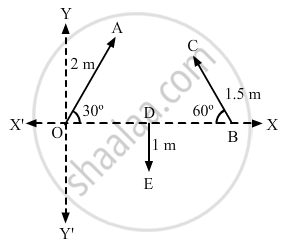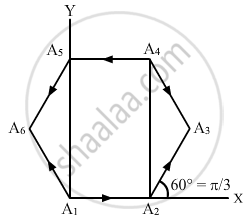Advertisements
Advertisements
Question
Is it possible to add two vectors of unequal magnitudes and get zero? Is it possible to add three vectors of equal magnitudes and get zero?
Solution
No, it is not possible to obtain zero by adding two vectors of unequal magnitudes.
Example: Let us add two vectors \[\vec{A}\] and \[\vec{B}\] of unequal magnitudes acting in opposite directions. The resultant vector is given by
\[R = \sqrt{A^2 + B^2 + 2AB\cos\theta}\]
If two vectors are exactly opposite to each other, then
\[\theta = 180^\circ, \cos180^\circ= - 1\]
\[R = \sqrt{A^2 + B^2 - 2AB}\]
\[ \Rightarrow R = \sqrt{\left( A - B \right)^2}\]
\[ \Rightarrow R = \left( A - B \right) \text { or } \left( B - A \right)\]
Yes, it is possible to add three vectors of equal magnitudes and get zero.
Lets take three vectors of equal magnitudes

\[A_x = A\]
\[ A_y = 0\]
\[ B_x = - B \cos 60^\circ\]
\[ B_y = B \sin 60^\circ\]
\[ C_x = - C \cos 60^\circ\]
\[ C_y = - C \sin 60^\circ\]
\[\text { Here, A = B = C }\]
So, along the x - axis , we have:
\[A - (2A \cos 60^\circ) = 0, as \cos 60^\circ = \frac{1}{2} \]
\[ \Rightarrow B \sin 60^\circ - C \sin 60^\circ = 0\]
Hence, proved.
APPEARS IN
RELATED QUESTIONS
“Every great physical theory starts as a heresy and ends as a dogma”. Give some examples from the history of science of the validity of this incisive remark
What are the dimensions of the ratio of the volume of a cube of edge a to the volume of a sphere of radius a?
It is desirable that the standards of units be easily available, invariable, indestructible and easily reproducible. If we use foot of a person as a standard unit of length, which of the above features are present and which are not?
A physical quantity is measured and the result is expressed as nu where u is the unit used and n is the numerical value. If the result is expressed in various units then
A unitless quantity
\[\int\frac{dx}{\sqrt{2ax - x^2}} = a^n \sin^{- 1} \left[ \frac{x}{a} - 1 \right]\]
The value of n is
Find the dimensions of
(a) angular speed ω,
(b) angular acceleration α,
(c) torque τ and
(d) moment of interia I.
Some of the equations involving these quantities are \[\omega = \frac{\theta_2 - \theta_1}{t_2 - t_1}, \alpha = \frac{\omega_2 - \omega_1}{t_2 - t_1}, \tau = F . r \text{ and }I = m r^2\].
The symbols have standard meanings.
Find the dimensions of Planck's constant h from the equation E = hv where E is the energy and v is the frequency.
Let \[\vec{A} = 3 \vec{i} + 4 \vec{j}\]. Write a vector \[\vec{B}\] such that \[\vec{A} \neq \vec{B}\], but A = B.
Can you have \[\vec{A} \times \vec{B} = \vec{A} \cdot \vec{B}\] with A ≠ 0 and B ≠ 0 ? What if one of the two vectors is zero?
A vector is not changed if
Refer to figure (2 − E1). Find (a) the magnitude, (b) x and y component and (c) the angle with the X-axis of the resultant of \[\overrightarrow{OA}, \overrightarrow{BC} \text { and } \overrightarrow{DE}\].

A spy report about a suspected car reads as follows. "The car moved 2.00 km towards east, made a perpendicular left turn, ran for 500 m, made a perpendicular right turn, ran for 4.00 km and stopped". Find the displacement of the car.
Let A1 A2 A3 A4 A5 A6 A1 be a regular hexagon. Write the x-components of the vectors represented by the six sides taken in order. Use the fact the resultant of these six vectors is zero, to prove that
cos 0 + cos π/3 + cos 2π/3 + cos 3π/3 + cos 4π/3 + cos 5π/3 = 0.
Use the known cosine values to verify the result.

Prove that \[\vec{A} . \left( \vec{A} \times \vec{B} \right) = 0\].
If \[\vec{A} , \vec{B} , \vec{C}\] are mutually perpendicular, show that \[\vec{C} \times \left( \vec{A} \times \vec{B} \right) = 0\] Is the converse true?
The changes in a function y and the independent variable x are related as
\[\frac{dy}{dx} = x^2\] . Find y as a function of x.
In a submarine equipped with sonar, the time delay between the generation of a pulse and its echo after reflection from an enemy submarine is observed to be 80 s. If the speed of sound in water is 1460 ms-1. What is the distance of an enemy submarine?
